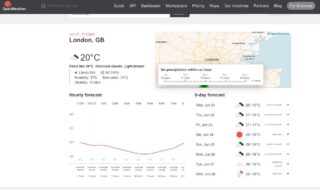The concept of big data is not a newly coined phenomenon. Even in the 1950s, businesses found their way around basic analytics to unveil insights and trends.
However, these days, big data analytics is going through a new stage of development with the upsurge of technology and fancy tools. Most organizations now can unearth data for both long-run and immediate decisions. This ability of rapid decision-making translates into an agile approach and a competitive edge unseen before.
We could ramble on about the importance of data analytics over and over again, but let’s dump it into a succinct guide and put the things into some context.
We’ll start with the data analytics definition.
Contents
What Is Big Data Analytics?
Data Analytics is a set of techniques that target big data from off-the-shelf systems developed by big data engineering. Big data analytics aims at analyzing trends, patterns, and developing various classification and prediction systems.
Currently, this term involves the following data-related processes:
- Data storage and management;
- Cleansing;
- Data mining;
- Data analysis;
- Data visualization;
- Data integration;
- Data grouping.
Also, it is important to realize that data comes in different flavors. Therefore, content preferences and search requests to online purchases can be the source of valuable insights.
The Many Faces of Data
Data is a buzzword. Therefore, you’ll likely bump into a dozen terms that incorporate this notion. Probably, the most popular ones are data analytics, data science, and data analysis. Both sound the same, but what is the main difference if any? Let’s lay it all out for you:
- Data analysis deals with collecting, manipulating, and studying the data to fetch a general insight;
- Data analytics further uses the analyzed data and helps make well-versed business decisions in a specified area;
- Data science helps expose new questions that you might not have considered before. It is an umbrella term that includes data analytics as well.
Therefore, all the three notions work towards the same goal, but each using a different set of techniques and digging with different depths.
The 4 Types of Data Analytics
Data analytics is a multi-faceted, complex process that uncovers hidden patterns for us to amplify our business operations. So it’s no wonder this science comes in various shapes and forms. Four main types of data analytics scrutinize big data from different perspectives.
Type 1. Descriptive analytics – What Is Happening?
Descriptive analytics interprets historical data to track and summarize changes and identify patterns. A prominent example of descriptive analytics is when IoT-enabled devices collect data from production equipment to prevent any costly unplanned downtime.
In business, this type of analytics usually paves the way for more complex analytics techniques. The result of descriptive analytics includes visualization output like pie charts and other basic graphical displays.
Thanks to its simplicity, this type of analytics is widely used across industries, including marketing, banking, and healthcare. Thus, Google Analytics leverages descriptive analytics to distill large volumes of data into a visual presentation.
In general, descriptive analytics helps companies to measure performance and reset perspective on goals and targets.
Here are some real-world examples of how this kind of analytics is implemented:
- Summing up previous events like deals and activities information or promoting efforts;
- Assessing digital engagement;
- Detailing general patterns;
- Gathering review results.
Type 2. Predictive analytics – What Could Happen?

Predictive analytics uses a variety of statistical, data analysis, and game theory methods to analyze current and historical data/events in order to predict future data/events. Let’s imagine that you’re planning on launching a new business and want to know whether it’ll be profitable. That’s what predictive analytics is all about, in simple terms.
Predictive analytics methods use the existing relationships among factors to assess possible risks. When applied to the loan approval process, it leverages scoring models to assess the solvency of the client. In this case, any scoring model relies heavily on historical data.
Other applications of this analytics type include:
- Ecommerce and retail – to perform behavior analytics, optimize trade promotions, and personalize in-store experiences;
- Marketing – to gain a better understanding of promoting efforts and trends in sales in the future;
- Human resource management – to track employee retention metrics and performance;
- Healthcare – to boost patient care by detecting early signs of patient deterioration and identifying at-risk patients;
- Finance and accounting – to predict revenue, improve supply chains, and detect loss drivers.
Type 3. Diagnostic analytics – Why It Happened?
Diagnostic analytics is a type of deeper advanced analytics that relies on the descriptive type. It analyzes the data to answer the question “Why did this happen?” Therefore, it allows you to identify the factors that influence the target parameters.
Also known as root cause analysis, it compares the accumulated data through sophisticated algorithms. Thanks to this type of analytics, we can now examine problems in detail, identify weaknesses, and determine pattern chains of events.
In a broader sense, diagnostic analytics is used to target the following focal points:
- Detecting anomalies: With the help of descriptive analysis, analysts can identify the phenomena that deviate from a dataset’s normal behavior.
- Drilling into the analytics: Data specialists are looking for data sources to further study the anomalies.
- Identifying root relationships: Deep patterns are unearthed by studying the source of the found anomalies.
Thus, if a descriptive report demonstrates a decline in sales, a diagnostic report can show that the decline stems from low marketing spending. By joining the forces of descriptive and diagnostic analytics, you can move on to predictive analytics.
Type 4. Prescriptive analytics – What Is The Best Solution?
This type of analytics focuses on the best course of action for a particular situation. While descriptive analytics demonstrates the tendencies and predictive analytics makes predictions, prescriptive analytics uses this information to offer you potential solutions, given the available data.
Therefore, prescriptive analytics obtains data from descriptive and predictive sources and implements them into the decision-making process. It can also assess the risk of a decision relying on various possible future scenarios.
Its applications areas include:
- Healthcare – to improve the outcomes for patients and measure the cost-effectiveness of various procedures.
- Airlines – to optimize ticket prices and availability based on a gamut of factors.
- Marketing – to flag the trend and offer the best course of marketing activities.
- Ecommerce- to offer intelligent recommendations to shoppers.
Top Use Cases For Big Data Analytics
Recommendation Engines
Recommendation systems are one of the most popular examples of how data analytics is adopted. Remember how Netflix knows exactly what your preferences are or Amazon suggests items you might enjoy? Every recommendation engine is based on big data supplies that include past purchases, browsing history, and others. All these allow the system to make relevant recommendations.
This use case is having such a big moment today that users expect to see it in your online store or streaming app. Therefore, if you haven’t tapped into big analytics for recommendation systems, you might be missing a share of loyal customers.
Internet Of Things
Big data and IoT are the two buzzwords that go hand in hand in the tech-savvy world. The enormous collection of connected devices generates dozens of zettabytes. Billions of sensors are used hourly for asset management, fleet tracking, remote health monitoring, and more.
And an increasing number of businesses grow to fetch valuable insights from the IoT technology. When we’re talking about preventive maintenance, sensors are used to collect data. The obtained data is then scrutinized using data analytics software to achieve actionable insights.
Customer Segmentation
A profound understanding of your target audience gives companies a competitive edge in the market. Besides, as customer acquisition costs are rising, it is especially useful to fine-tune your marketing efforts. Data analytics helps divide customers into groups based on common characteristics like transactional data, purchase history, and others.
After that, companies can correlate customer behavior with their marketing activities and brew up personalized offers and reduce customer acquisition costs.
Overall, the use of data analytics for marketing can be boiled down to three outcomes:
- Defining the target audience;
- Identifying active/loyal customer groups;
- Targeting a particular type of content or product to segmented groups.
Other textbook examples of data analytics usage include market research, fraud prevention, and price optimization.
The Final Word
It doesn’t matter how big your data sets are or how good you’re at collecting fresh data. If you’re unable to crystallize actionable insights from it, you won’t avail of its diverse forms and multiple sources.
Data analytics is what helps you strain the abundance of data and transform it into pure gold. So take advantage of this technology to navigate the business terrain effectively.



